The drug Cofasma is popular not only due to its effectiveness, but also because the drugs produced in liquid form differ short absorption time in the gastrointestinal tract, compared to drugs in tablet form, which take time to dissolve in intestines. Therefore, often for pediatric therapy doctors advise using syrups.
Record content:
- 1 Active ingredients
- 2 Selling features
-
3 Mechanism of action
- 3.1 Pharmacokinetics of salbutamol
- 3.2 Pharmacokinetics of bromhexine
- 4 Who is shown
- 5 Contraindications
- 6 Overdose
- 7 Application rules
- 8 Precautionary measures
- 9 Compatibility with other medications
- 10 Storage conditions and periods
-
11 Analogs
- 11.1 Jocet
- 11.2 Ascoril
- 11.3 Kashnol
- 11.4 Bronchostop
- 12 Cough medicine videos
Active ingredients
The preparation, which is a syrup, contains: bromhexine in the amount of 4 mg, salbutamol - 2 mg, the composition also contains guaifenesin. Available in 100 ml bottles.
Selling features
The drug can be bought in pharmacy chains with a prescription. Cost - 199-200 rubles.
Mechanism of action
It is a combination drug, has a bronchodilator effect, mucolytic, as well as expectorant effects.
Cofasma (syrup for children) contains several ingredients. Salbutamol - one of the components of this drug, has bronchodilator effects, stimulating acts on bronchial beta2-adrenergic receptors, and beta2-adrenergic receptors of the muscles of the uterus and blood vessels.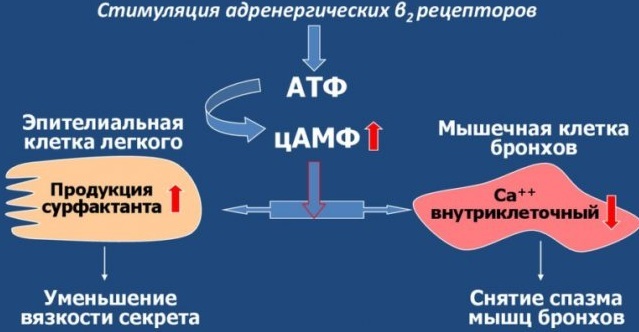
It has a preventive or suppressive effect on bronchospasm, relaxes the airways, acting on the lungs, increases their vital capacity. Does not lower blood pressure, weakly affects cardiac beta1-adrenergic receptors, dilates the blood vessels of the heart.
When used in the recommended dosage, it does not negatively affect blood vessels and the heart, does not increase blood pressure. It has a weaker positive inotropic and chronotropic effect than other drugs in this group.
Affects metabolism: under the influence of the drug in the plasma, the level of potassium decreases, the agent acts on glycogenolysis, as well as on the release of insulin, has lipolytic effect, increases blood glucose levels (especially if the patient has bronchial asthma) and increases the risk of acidosis.
Pharmacokinetics of salbutamol
If used by inhalation, then 10-20% of the administered drug penetrates into the lower part of the bronchi. The rest of the medicine remains in the device or on the mucous membrane of the mouth and larynx and is then swallowed. The medicinal substance, which has settled on the bronchial mucosa, is absorbed into the lung tissue and blood (it is not metabolized in the lungs).
Salbutamol is about 10% bound to plasma proteins.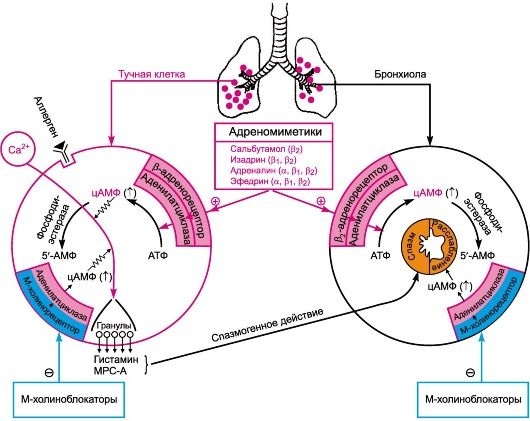
This drug, taken orally, after absorption from the gastrointestinal tract undergoes hepatic metabolism, while it turns into such an inactive metabolite as phenolic sulfate. Conjugates and unchanged salbutamol are excreted to a greater extent in the urine.
Salbutamol has a half-life of about 4 to 6 hours. Only a small part (4%) is excreted in bile and feces. The main part of the drug taken is released in 72 hours.
Cofasma contains bromhexine, a mucolytic substance that dilutes phlegm, has an expectorant secretolytic effect, and additionally acts as a weak antitussive drug.
Increases the amount of phlegm. Under the action of bromhexine, which is contained in this syrup for children, the secretion of endogenous surfactant, which is necessary for the stability of alveolar cells during respiration, increases. The therapeutic effect becomes noticeable approximately 2-5 days after the start of therapy.
Pharmacokinetics of bromhexine
99% of bromhexine taken orally in the gastrointestinal tract is absorbed in about half an hour. Bioavailability is approximately 80%. The drug is 99% bound to plasma proteins.
The drug is found after taking it in breast milk during lactation. Hepatic enzymes are demethylated and oxidized, with the formation of ambroxol. The half-life of bromhexine is 15 hours. Its excretion occurs through the kidneys already in the form of metabolites.
If the patient has chronic renal failure, excretion of metabolites is difficult. With long-term treatment, bromhexine can accumulate in the body.
Guaifenesin is a mucolytic drug that acts by enhancing the secretory activity of the bronchi. At the same time, the mucous membrane of the bronchi secretes neutral-type polysaccharides.
Under the action of guaifenesin, mucopolysaccharides are depolymerized, sputum liquefies, in the bronchial system ciliary the device is activated, and the sputum begins to be excreted more easily from the unproductive, the patient's cough turns into productive.
Who is shown
Cofasma (syrup for children) is used in the treatment of pathologies of the lungs and bronchi, with which have difficulties with the discharge of viscous sputum from them, these are:
- tuberculosis;
- pneumoconiosis;
- chronic obstructive pulmonary pathologies;
- pneumonia;
- tracheobronchitis.
In the treatment of children, when using cough syrups, it is much easier to solve the problem of a child's negative emotional reaction to a remedy or even a refusal to take the medication. Most syrups are pleasant to the taste and also have a pleasant aroma.
Additionally, the use of syrups is advised for those who have difficulty using tablet medicines, for example, with dysphagia, in which taking pills provokes a pronounced gag reflex, or if the patient has a pronounced weakening.
Contraindications
Contraindications to taking Cofasma are the following conditions:
- increased susceptibility to the constituent substances of the drug;
- lactation;
- tachyarrhythmia;
- period of bearing the child;
- bleeding from the stomach;
- high blood pressure;
- aggravated ulcerative pathology of the duodenum;
- aggravated gastric ulcer;
- the presence of kidney and / or liver failure;
- the presence of glaucoma;
- aortic stenosis;
- myocarditis;
- decompensated type of diabetes mellitus;
- the presence of thyrotoxicosis in the patient.
During therapy with this remedy, the following side effects may appear:
- the appearance of drowsiness;
- insomnia or drowsiness;
- the development of excessive psychological excitability;
- the appearance of dizziness;
- the appearance of headaches;
- development of diarrhea;
- vomit;
- the appearance of atremor;
- feeling of nausea;
- the development of a convulsive reaction;
- transition of duodenal ulcer pathology to an acute form;
- the transition of gastric ulcer pathology into an aggravated form;
- lowering blood pressure;
- the appearance of tachycardia;
- collapse;
- rarely - increased activity of liver transaminases.
- the appearance of a rash on the skin;
- paradoxical narrowing of the bronchi;
- urine may turn pink;
- development of urticaria.
Overdose
There is no data on overdose by Kofasma. Side effects of the medication may increase. In this case, therapy is symptomatic.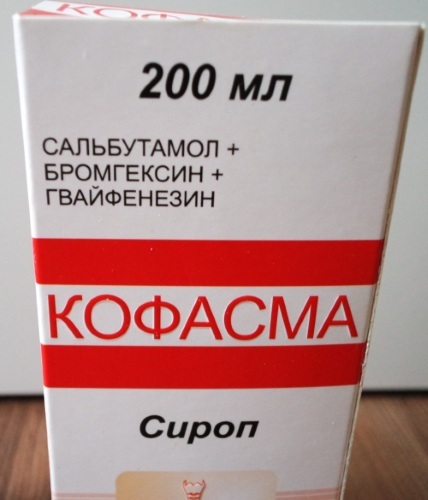
Cofasma (syrup for children) in case of an overdose due to exposure to salbutamol can cause:
- dilatation of peripheral vessels;
- hypokalemia;
- flutter of the ventricles;
- tachyarrhythmia;
- the occurrence of seizures;
- the appearance of hallucinations;
- headaches;
- the development of hypoxemia;
- increased blood glucose;
- psychomotor agitation;
- development of respiratory alkalosis;
- lowering blood pressure;
- vomiting;
- feeling of nausea;
- the appearance of muscle tremor;
- heart palpitations (tachycardia).
If an excessive dose of salbutamol is taken, then the most effective antidotes are cardioselective antagonists of beta-adrenergic receptors. But in order to avoid bronchospasm, beta-blockers are used with precautions.
When using high dosages of salbutamol, hypokalemia is possible. In this regard, if there is a suspicion that there is an overdose, it is necessary to monitor the level of potassium in the blood.
If you take too large a dose of bromhexine, you may experience:
- nausea;
- vomit;
- diarrhea and other gastrointestinal disorders.
Bromhexine overdose therapy: there is no specific antidote. If an excessive dose of the drug is taken, vomiting should be induced, after which the patient should be given a liquid (water, milk). It is necessary to perform gastric lavage for 1-2 hours after taking an excessive dose.
Application rules
Cofasma syrup is used orally. The dose for 1 admission is calculated depending on the age of the patient who has a pathology. Frequency rate of admission - 3 r / day.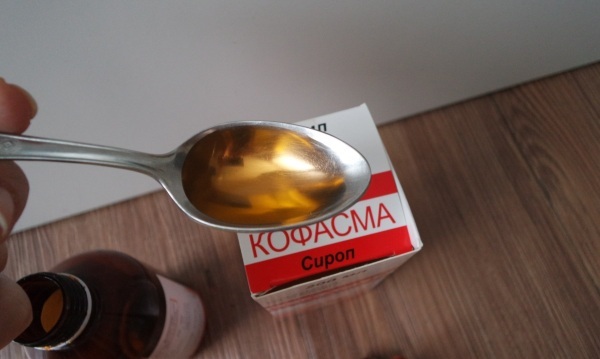
Dosages for the treatment of children:
| Age | The amount of the drug |
| Up to 6 years old | 5 ml for 1 dose |
| 6-12 years old | 5-10 ml at a time |
Dosage for children over 12 years old, as well as adults, is 10 ml of syrup at a time.
Precautionary measures
Care must be taken when:
- ulcerative pathology of the duodenum, stomach;
- arterial hypertension;
- violation of carbohydrate metabolism;
- the simultaneous use of monoamine oxidase (MAO) inhibitors, cough medicines, non-selective adrenergic blockers (for example, propranolol).
The drug leads to the potentiation of the action of CNS stimulants. Xanthines (eg, theophylline), when taken with Cofasma, increase the risk of tachyarrhythmias; levodopa, drugs from the group of inhalation anesthetics anesthesia by the method of severe ventricular arrhythmias.
When combined with m-cholinergic receptor blockers, it can lead to an increase in intraocular pressure. When combined with glucocorticosteroids and diuretics, the possibility of developing hypokalemia increases.
Lyell and Stevens-Johnson syndromes have rarely been observed due to bromhexine, which is contained in this drug. If changes appear on the skin or mucous membranes, you should immediately stop using the medicine and seek medical help from a specialist.
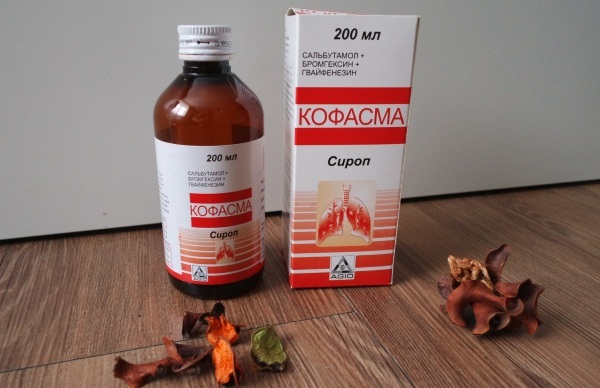
When treating with this medicine, doctors advise to consume enough fluid - this helps to maintain the effect of bromhexine in reducing the viscosity of sputum. When treating children, it is necessary to simultaneously produce vibration massage or postural drainage of the chest, which help to facilitate the removal of bronchial mucus.
Bromhexine is able to penetrate breast milk and through the placental barrier. During the carrying of a child and during lactation, the medicine cannot be used.
If during lactation treatment with this medicine is necessary, then breastfeeding is stopped for this time interval. Under the influence of guaifenesin, the urine turns pink. Doctors do not advise using alkaline drinks with the drug.
Due to the possible appearance of drowsiness, the development of dizziness and other undesirable effects, doctors advise during therapy with this drug to refrain from managing various mechanisms and vehicles and from other activities that are potentially dangerous, and in which a high concentration of attention and speed of mental and motor reactions.
Compatibility with other medications
Xanthines such as theophylline, when used in combination with Cofasma, increase the risk of developing tachyarrhythmias.
Inhibitors of monoamine oxidase (MAO) and tricyclic antidepressants (tricyclic antidepressants) enhance the action of salbutamol, and can cause a sudden drop in blood pressure.
Kofasma (syrup for children), when combined with inhaled m-anticholinergics, can increase intraocular pressure.
The drug cannot be combined with non-selective beta-adrenergic receptor antagonists. Glucocorticosteroids and diuretic drugs lead to increased hypokalemia from salbutamol. Combined use with codeine-containing drugs and other cough suppressants slows down the separation of sputum from the bronchi.
Under the action of bromhexine, sulfonamide drugs and drugs from the group of antibiotics quickly penetrate the bronchial mucus in the first 4-5 days of treatment with them. Concomitant treatment with bromhexine and a number of NSAIDs (eg, butadione, salicylates, phenylbutazone) can irritate the stomach.
Storage conditions and periods
During storage, the drug should be kept in a tightly sealed bottle at an ambient temperature of no more than 25 degrees. The medicine must not be frozen. Store in a place that is out of reach of children. The syrup has a shelf life of 2 years. It is forbidden to use a product with an expired shelf life, which is indicated on the package.
Analogs
Cofasm syrup has a number of analogues, such as:
Jocet
It is a bronchodilator remedy. This drug acts as a mucolytic and also has an expectorant effect. It is produced in the form of a medicinal syrup.
Jocet has a special measuring cup in its kit. The vial containing the syrup with the medicine is packed in a cardboard box. 10 ml of Jocet's medicinal syrup contains: 1 mg of salbutamol (beta2-adrenomimetic), 50 mg of guaifenesin, as well as 2 mg of bromhexine and menthol, in an amount of 0.5 mg.
The drug is administered orally. Dosage regimen of Jocet: children under 6 years of age are given Jocet in a dosage of 5 ml 3 times a day, Jocet syrup for children from 6 to 12 years old is prescribed 5-10 ml 3 times a day. For children over 12 years old, and for adult patients, the recommended dosage is 10 ml 3 times a day. Price - 142-261 rubles.
Ascoril
The drug is produced in tablet form (tablets of 10 pcs. placed in a cellular package, which in turn is placed in a pack of cardboard, the pack contains 1, 2 or 5 pcs.). 1 tablet contains: bromhexine, as well as guaifenesin and salbutamol.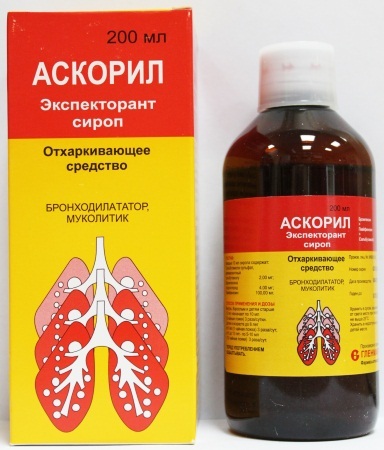
Ascoril is used orally. Doctors advise children over 12 years old to use 1 pc. 3 r / day, children 6-12 years old - in the amount of 1/2 or 1 tablet 3 r / day. The price of Ascoril varies from 177 to 342 rubles.
Kashnol
It is produced in the form of a syrup. The cardboard box contains a measuring cup for dispensing Cashnol. The syrup contains: menthol, salbutamol, as well as bromhexine and guaifenesin.
Kashnol is used internally. The recommended dosage for patients is 3 r / day: children aged 3-6 years - 5 ml, children 6-12 years old should be given 5-10 ml of Cashnol. For adults, patients, as well as for children from 12 years old, the dosage of Kashnol is 10 ml. An interval of at least 6 hours should be maintained between doses of the drug. The cost is 116-148 rubles.
Bronchostop
It is transparent, colorless or slightly yellowish in color, with a vanillin aroma (a cardboard box contains 1 bottle in 100 ml, a spoon and a measuring cup). 5 ml contains 4 mg of bromhexine.
The medicine is used orally, regardless of food intake. Doctors advise taking Bronchostop in the following dosages: 3 r / day: children under 2 years old - 2 mg; 2-6 years old - 2-4 mg of syrup; from 6 to 14 years old - 4-8 mg. For adult patients and children from 14 years of age, the dosage is 8-16 mg 3-4 r / day. The cost is approximately 500 rubles.
The drug Cofasma, when taken after a doctor's appointment, can eliminate cough and facilitate easier excretion of phlegm. This syrup for children is one of the most effective for cough therapy.
Cough medicine videos
Treatment of cough, bronchitis:



